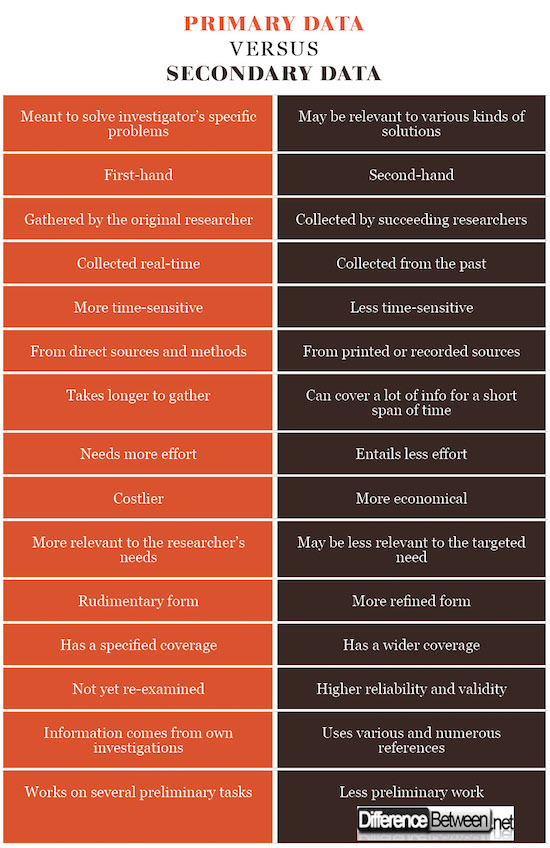Difference Between Primary Data and Secondary Data
Primary and secondary data are important in information gathering may it be quantitative or qualitative. They are essential in statistical analyses and are sometimes compared with each other to verify changes. Also, they can fill in each other’s gaps by employing their particular approaches. The following discussions present their respective definitions and differences.

What is Primary Data?
Primary data, which is first collected, is highly factual as it is the original source of the material. Its main purpose is to provide solutions to the researcher’s problems. It utilizes a direct approach as the information is collected through naturalistic observation, experiments, focus group discussions, personal interviews, questionnaires and other first-hand methods. Thus, this kind of data is decidedly useful in studying specific and time-critical evidence.
These are the requirements in evaluating primary data:
- Reliability
The information should be trustworthy and supported by other primary sources.
- Origin
Gathered data should have a definite source. If the author’s real name is not given, it has less credibility.
- Validity
It must be well-founded and reinforced by an authority.
- Accuracy
As human beings often commit mistakes, information should be carefully verified.

What is Secondary Data?
Secondary data is the interpretation of the initial or primary data as it was originally collected by another researcher. It is largely available in journals, newspapers, records, and other publications. Due to its nature, it is not often utilized for time-sensitive data such as marketing research as the available material may already be inaccurate or passé.
Secondary data is quite beneficial specially when it comes to quantitative information as it can cover large databases. Hence, this kind of evidence gathering is much more economical regarding time, effort, and cost.
These are the requirements in evaluating secondary data:
- Suitability
The information ought to be relevant to the researcher’s needs.
- Objectivity
A balanced perspective must be considered in choosing sources.
- Accuracy and Credibility
Other sources should corroborate the information. The materials must also meet their respective academic and professional qualifications.
- Authority
The author should indeed be an established expert in the field. Also, the material should have been published by a reputable company.
- Timely
Recent findings should be reflected. Hence, newer editions are favorable.
Difference between Primary and Secondary Data
Purpose of Primary and Secondary Data
Primary data is meant to assist in providing solutions to the researcher’s specific problems while secondary data may also be for other purposes.
Sequence of Primary and Secondary Data
As their names suggest, primary data comes first while secondary data comes second.
Data Gatherer
The original researcher gathers the primary data whereas the secondary data is generally collected by someone else.
Timing of Primary and Secondary Data
Primary data is collected real time. On the other hand, secondary data is retrieved from the past.
Source
Primary data are from interviews, questionnaires, experiments, observations, and similar methods. However, secondary data are from already printed or recorded sources such as censuses, government/organizational records, articles, books, websites, journals, and the like.
Duration
Primary data is generally collected longer as the information is still being uncovered and verified. On the contrary, secondary data is from already substantiated sources.
Effort
As compared to secondary data, primary data require more effort as the facts still need to go through several validation procedures.
Expenses
Most likely, primary data entails more expenses as it requires a longer period of time as well as additional efforts.
Relevance of Primary and Secondary Data
Primary data is collected due to the specific needs of the researcher whereas secondary data may or may not be that relevant.
Form
As primary data is first-hand, it is generally obtainable in its rudimentary form while secondary data is available in its already refined form.
Time-Sensitive
As compared to primary data, secondary data may not be appropriate for time-sensitive topics since previously collected information may not reflect current situations. Thus, primary data is more beneficial for issues which are only applicable or observed for a certain time.
Coverage
Since the primary investigator can only examine crude data at a certain time, secondary data has a wider coverage as it may include research from various authors at differing times.
Validity and Reliability of Primary and Secondary Data
Secondary data is more valid and reliable since it has already been re-examined and many of them have established their credibility by being published or promoted. On the other hand, primary data may still need to go through authentication and consistency verification processes.
References
Secondary data tend to have more references as it employs a substantiation of different documents from a number of sources. On the other hand, primary data is largely from the original investigator.
Preliminary Work
In collecting primary data, much preliminary work such as background information, looking for respondents, and specification of locale still needs to be done. In the case of secondary data, the initial tasks have already been completed and the available materials are already sorted and reviewed.
Primary Data vs Secondary Data : Comparison Table

Summary of Primary vs. Secondary Data
- Both primary and secondary data are crucial in research.
- Primary data is firsthand information from direct sources.
- Secondary data was previously gathered and is often used to support primary data.
- As compared to primary data, secondary data is more economical in terms of time, money, and effort.
- As compared to secondary data, primary data is more specific, relevant, and beneficial for time-sensitive topics.
- Difference Between Hematoma and Melanoma - February 9, 2023
- Difference Between Bruising and Necrosis - February 8, 2023
- Difference Between Brain Hematoma and Brain Hemorrhage - February 8, 2023
Search DifferenceBetween.net :
Leave a Response
References :
[0]Mac Austin, Hilary, and Thompson, Kathleen. Examining the Evidence. North Mankato: Maupin House, 2014. Print.
[1]Patzer, Gordon. Using Secondary Data in Marketing Research. California: Praeger, 1995. Print.
[2]Trzesniewski, Kali, Donnellan, Brent, and Lucas, Richard. Secondary Data Analysis. Virginia: American Psychological Association, 2010. Print.
[3]Image credit: https://pxhere.com/en/photo/969162
[4]Image credit: https://pxhere.com/en/photo/1395341
